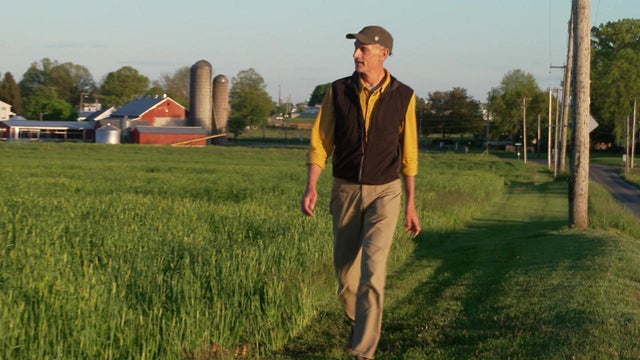"American Ramble": A writer's walk from D.C. to New York, and through history

In March 2021, Neil King Jr., left his home in Washington, D.C., and went for a walk. He would walk 330 miles, all the way to New York City. It took him 26 days.
After a career as a Wall Street Journal reporter, the walk was his way of contemplating America, past and present – and, at 61, his own life after surviving esophageal cancer. "I was off to do something that was very pure and basic," King said, "which was just to notice things and immerse myself in a walk through one spring that had kind of cleansed my eyes in some ways, or my spirit."
Just weeks after the January 6th attack on the Capitol, after a year of COVID, what King experienced along the way, sticking to back roads, would become a book: "American Ramble."
He retraced his steps this spring for "Sunday Morning," heading off down the Mall with the U.S. Capitol at his back.
Teichner asked, "Did you feel the weight of who we are now and what we are as a country as you set forth?"
"Yeah, very much so," King replied. "I mean, this is the front yard, the nation's front yard. It just seemed like the perfect place to start this walk."
He crossed the Mason-Dixon Line, the exact line between Maryland and Pennsylvania that, until after the Civil War, was the dividing line between slavery and freedom. It runs right through the middle of a 19th century farm.
King asked himself, whose history gets forgotten, and whose gets remembered? Who are the memory keepers?
Up the road in York, Pa., Teichner visited one memory-keeper, Mayor Michael Helfrich. He said, "In the 1920s you had the migration of African Americans up from Bamberg, South Carolina. But by the 1950s and 1960s the great fathers of the community decided it was a ghetto, and they used the first use of eminent-domain to wipe out the entire neighborhood."
That land became a park, and a business' parking lot.
The much older Cookes House, built in 1741, barely escaped demolition. Helfrich lives in it, and has turned it into a shrine to founding father Thomas Paine, who stayed here during the Revolutionary War.
Across town, King met another of York's memory-keepers, Samantha Dorm, who leads the restoration of York's long-neglected African-American Lebanon Cemetery. Among those buried here: Underground Railroad conductors. "We have United States colored troops; I believe we have about 32 that fought during the Civil War," said Dorm. "Since 2019, our volunteer group coming out here, we've uncovered over 800 of the flat markers."
The point is to rescue the stories of lives.
Dorm said, "It makes a difference when you're learning about people who not only look like you, but who are related to you, and to be able to say, I come from greatness. I know now that I'm related to over 100 individuals on this land alone of my family."
Time became a thing that awed Neil King as he made his way along the Susquehanna River with Paul Nevin, whose passion is Native American petroglyphs, possibly a thousand years old.
As King walked, time seemed to slow down, and then stop altogether, as he found himself among Pennsylvania's Mennonites. He chanced upon this:
And then this…
King said, "The serendipity was almost the magic. I met so many great people that I almost felt were put there by some higher power to interact with me."
He drifted from the ethereal to the concrete, to the very real world of everything his walk was not. Narrating a video he took during his walk, King proclaimed, "I have arrived at where I've wanted to come, which is the heart of darkness itself: that is to say, the Jersey Turnpike, I-95, the main artery of commerce for the United States of America."
Time took on new meaning as he toured the final resting place of some of that commerce, New Jersey's Middlesex County landfill, with Brian Murray, the man who runs it. Murray explained: "We tip about 1,600 tons of garbage a day, and last year we buried somewhere around just shy of about 540,000 tons of garbage."
On top of an astonishing garbage mountain that will rise another 12 feet this year, itself a measure of time. Walking through the landfill, King noted its elevation: "I think we're, like, the early '60s, maybe the late '50s. So, end of the Eisenhower administration basically," he said. "And up there is today."
As King crossed the Bayonne Bridge, he spotted his destination: Manhattan. "I was just sort of overwhelmed," he recalled. "It was like I was hit by a wave of elation, rapture. A full body sense of elation. … My eyes had been renewed in a way."
A day later, Neil King Jr.'s American ramble ended at the Ramble in New York's Central Park, a twisted network of paths that reminded him of the complexity of the country he had sampled.
He said, "In the end, I think the walk, despite all the kind of gloomy thoughts that you can have about various episodes from our history and our past, left me a lot more optimistic, in a way, about our future than had been the case when I walked out the door!"
To find gratitude and joy at three miles an hour, traveling light.
BOOK EXCERPT: "American Ramble: A Walk of Memory and Renewal"
For more info:
Story produced by Dustin Stephens. Editor: Remington Korper.
source: https://www.cbsnews.com/news/american-ramble-neil-king-jr-on-his-walk-from-washington-d-c-to-new-york-city/